Dell Precision T7920 Workstation Deep Learning Benchmarks
Deep learning training and inferencing workloads utilize GPUs heavily. Here, we can lean on our large data set to give some comparisons showing just how fast the Quadro RTX 8000 is.
ResNet-50 Inferencing in TensorTR using Tensor Cores.
ImageNet is an image classification database launched in 2007 designed for use in visual object recognition research. Organized by the WordNet hierarchy, hundreds of image examples represent each node (or category of specific nouns).

Using precision of INT8 is by far the fastest inferencing method if at all possible converting code to INT8 will yield faster runs. Installed memory has one of the largest impacts on these benchmarks which the Inferencing on NVIDIA RTX graphics cards does not tax the GPU’s to a great deal, however additional memory allows for larger batch sizes, the NVIDIA Quadro RTX 8000 could easily do batch sizes of 500+.
Let’s look at FP16 and FP32 results.
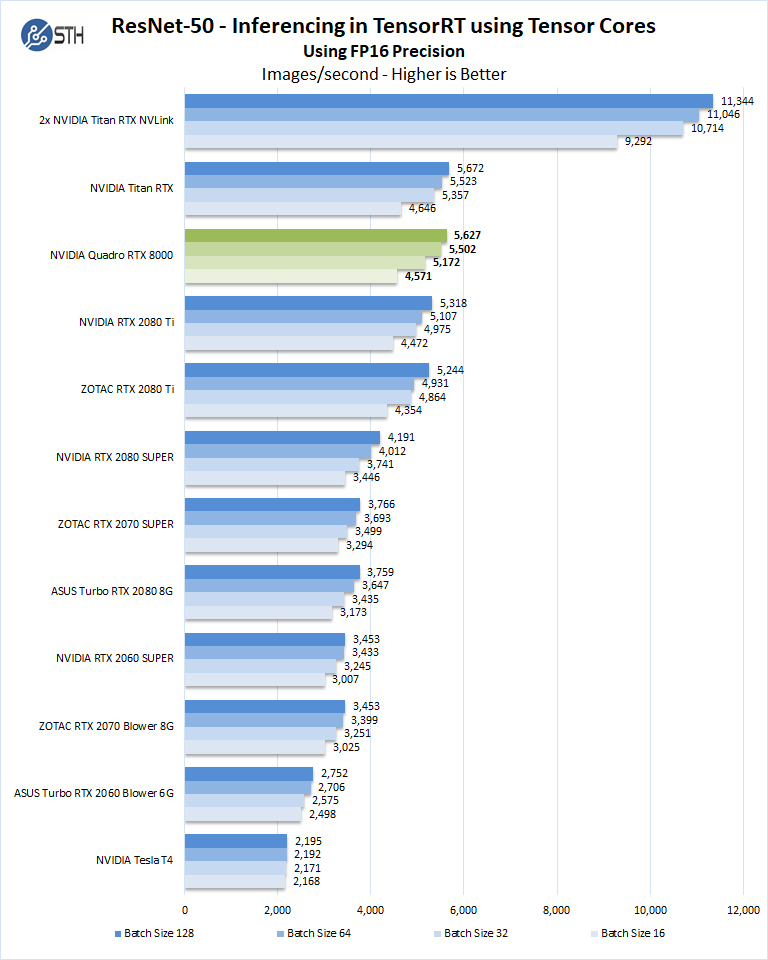
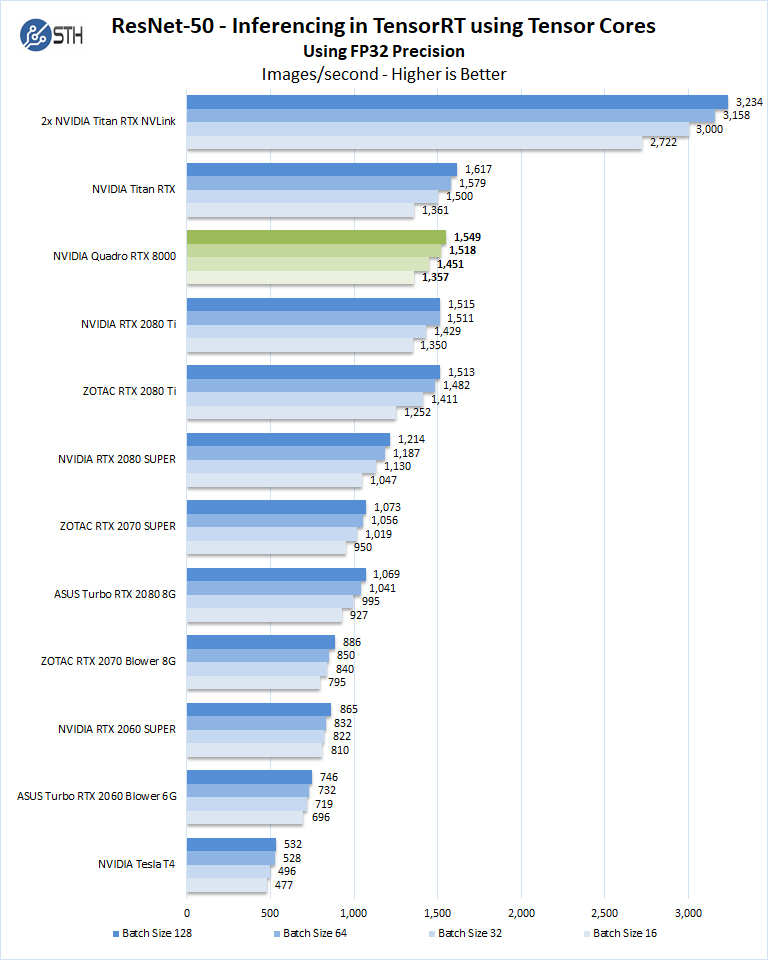
For inferencing workloads using NVIDIA CUDA, the Dell Precision T7920 performs extremely well.
ResNet-50 Training using Tensor Cores.
We also wanted to train the venerable ResNet-50 using Tensorflow. During training the neural network is learning features of images, (e.g. objects, animals, etc.) and determining what features are important. Periodically (every 1000 iterations), the neural network will test itself against the test set to determine training loss, which affects the accuracy of training the network. Accuracy can be increased through repetition (or running a higher number of epochs.)
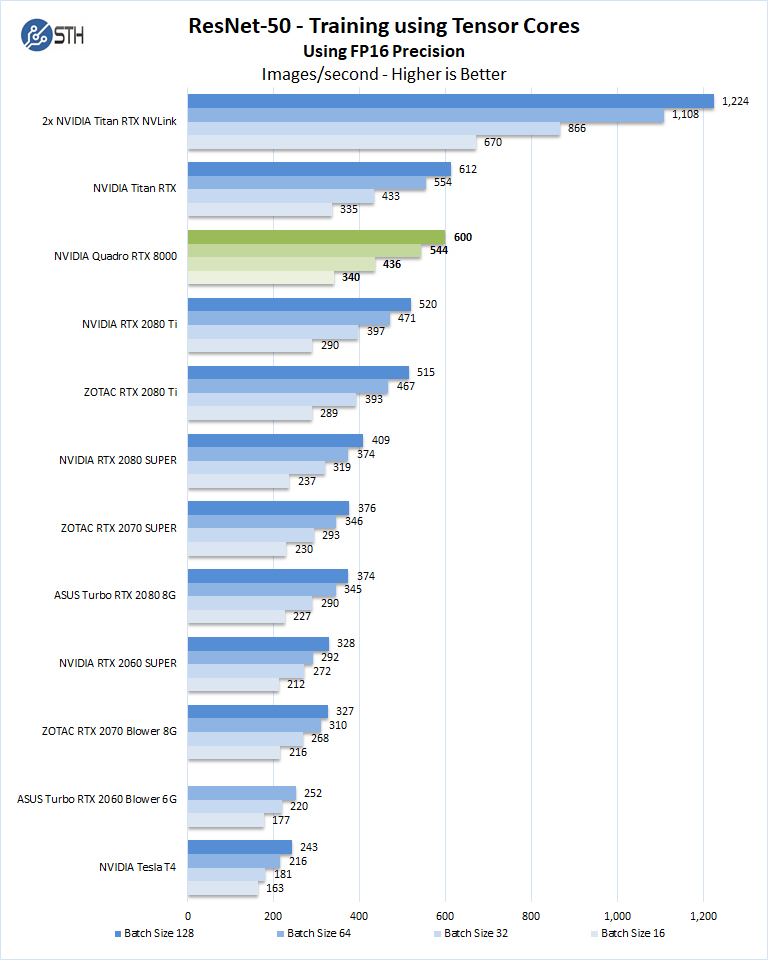
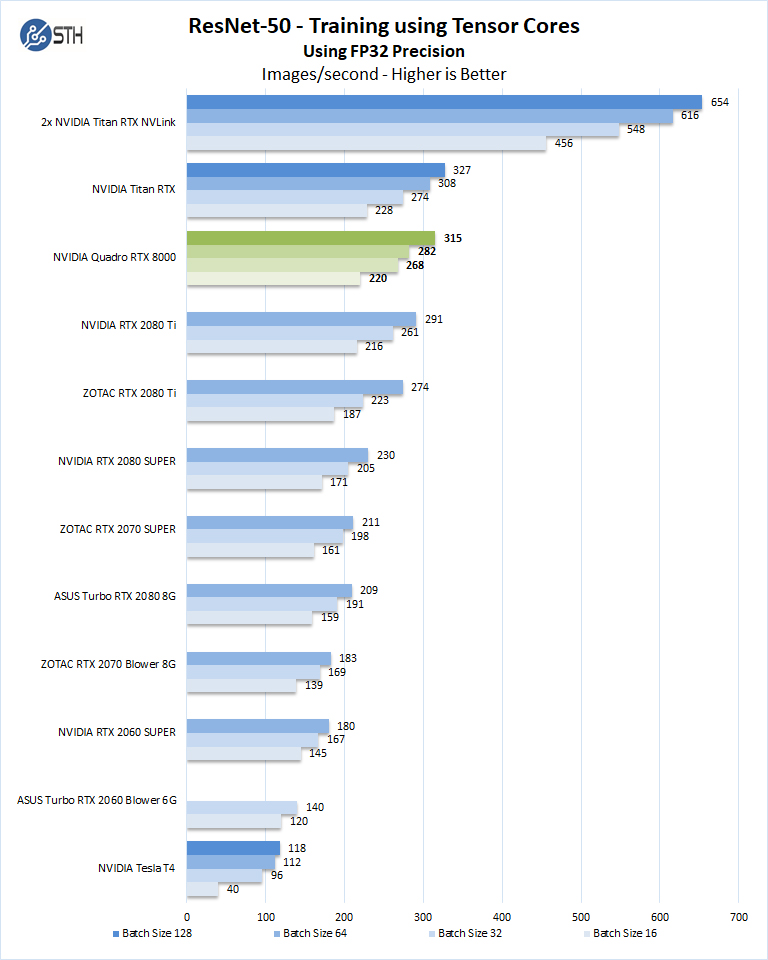
Here, again we can see excellent performance from the Quadro RTX 8000 in the Dell Precision T7920.
Training using OpenSeq2Seq (GNMT)
While Resnet-50 is a Convolutional Neural Network (CNN) that is typically used for image classification, Recurrent Neural Networks (RNN) such as Google Neural Machine Translation (GNMT) are used for applications such as real-time language translations.
We should note that other consumer GPUs we have tried on this benchmark could not complete training due to the lack of installed memory.
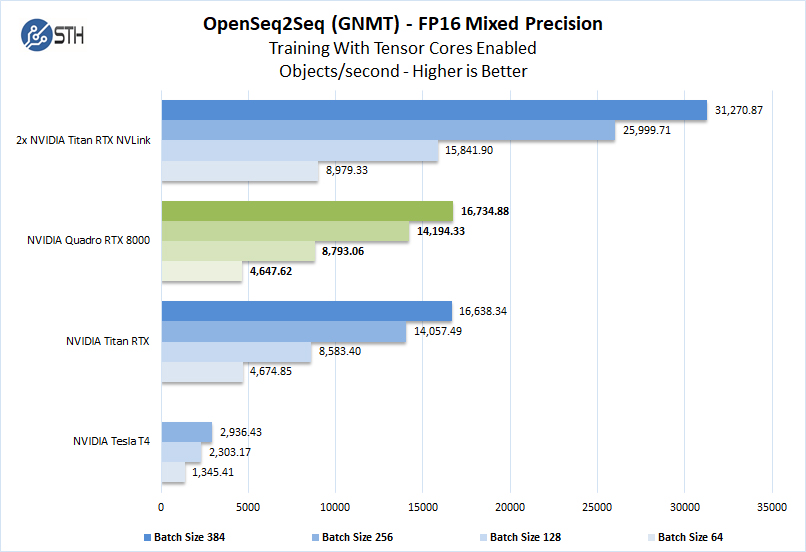
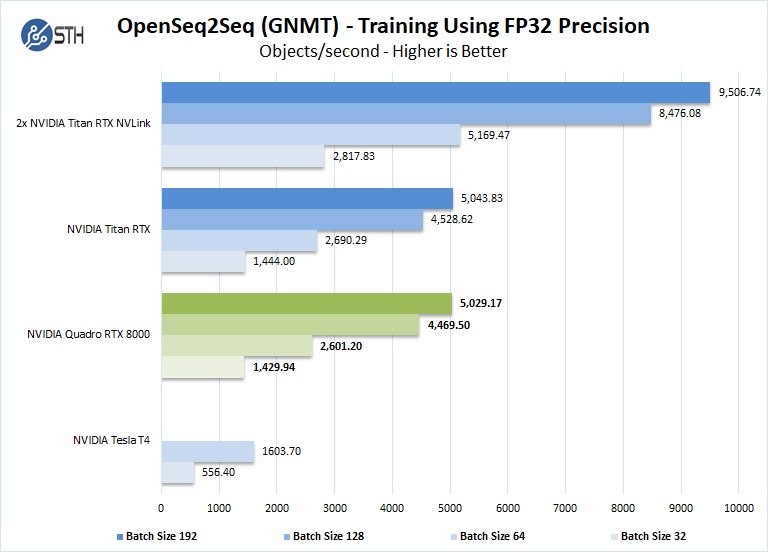
As the NVIDIA Quadro RTX 8000 has 48GB of installed memory, double that of the Titan RTX. The Quadro RTX 8000 is easily equal to the Titan RTX but offers larger batch sizes on a single GPU. Offering the ability to house multiple NVIDIA Quadro RTX 8000 GPUs in the Dell Precision T7920 allows for desktop data science to be done at levels formerly reserved for the data center.
Next, we are going to look at AIDA64 CPU Benchmarks.




I’ve got one of these in the office – great machine, and I love the layout of the motherboard (lenovo is also using a layout like that now too), but theres some things to look out for depending on what you’re using it for and how you’re using it:
1- if you have nosy coworkers who like looking at the hardware in the chassis, just show them the machine before its turned on, since opening the chassis during operation will shut the machine down while triggering a chassis intrusion alarm. At least on my early model, it also bugged out the dell support assist feature so it permanently thinks a fan is broken, when that fan was never installed on that model.
2- in order to keep the overall width of the unit within reason for product dimensions and cooling reasons, the clearance for cards is roughly equivalent to a 3U server. In places, that is actually slightly less, because the side panel latch has an internal bump running the height of the server. Tall cards like some consumer GPUs will not fit in this case, nor will short-length consumer GPUs that have outward/side facing (as opposed to front facing) pcie power plugs, as the bump will be in the way of the cable. Long standard height consumer GPUs with side facing pcie power plugs will fit, but you might have to squeeze the cabling a bit
3- There were 3 included pcie 8/6pin cables. If you are using consumer GPUs, you may need to buy additional cables from dell or use splitters. At the time I bought my unit, dell did not have the cables for purchase individually, but I managed to cludge an equivalent cable together out of adapters, since the PSU breakout board’s connectors for the pcie power plugs have the same pinout as (cont in next)
3 (cont)- the plug would on the pcie card as well.
4- If you want NVME support, you’ll need an adapter. You can bifurcate the lanes, but not explicitly – there is a setting in the bios (i forget which, but it has to do with pcie ssds), that you can toggle. Out of the box it was set to a setting where it would not detect dell’s own quad nvme adapter card, and dell’s enterprise support doesn’t have enough experience with those cards (or even the product specifications on hand) to do more than manually walk through trial and error experimentation of figuring out how to use the card in this machine. Turns out its that bios setting.
5- If you need audio for the work you intend to do on this machine and are expecting to get by with the motherboard audio since its usually ‘good enough’ on highend prosumer motherboards, you will be disappointed. Get a soundcard for this – I didn’t need amazing audio or anything, just audio good enough to listen to people speaking during meetings and checking the contents of files I was processing or working with, but the built in audio was really bad.
It should be kept in mind that my forewarnings are based on a very early unit (I got it within a month of launch, since I needed something more powerful right then in order to complete a project)
Despite these issues I encountered, I still very much like this machine, and they wont be problems for everyone.
Thanks for the info Syr. I am curious about your point #3 — I have avoided Dell workstations because they only offer 8/6 pin PCIe power connectors, while most consumer GPUs (e.g. 2080 Ti) require 8/8 connectors. It would be great to learn more about how you figured this out.
Dell, HP and Lenovo have very nice laptops, their workstations… not really value for money
Hi Michael – to clarify what I had meant by 8/6 was that the cables included with the system supported the full 6+2 connector, but only 1 per cable. The system came with 3 such cables pre-installed, but had 4 available headers, thus I was able to determine the pinout by simply matching the cables on the card side to the PSU breakout board side. It helped that Dell used standard cable color codes (yellow for +12 and black for 0).
I’m using 2x 1080ti cards in the system with 2x 8-pin plugs on them for a total of 4 plugs required, so I had to cobble together a cable out of adapters to power the second plug on the second card from the 4th empty plug on the PSU breakout board.
Syr–thanks for the reply! So it sounds like there are a maximum of 4 x 8 PCIe plugs available. That’s enough for 2 consumer GPUs. A 3rd GPU may not be possible.
If Dell went for AMD route, a system with 2x EPYC 7352 would be much cheaper with more PCIe lanes.
How well did the Thunderbolt work?
Thanks for the review. Also curious about the Thunderbolt support.
I hope this will help someone who is considering the purchase of a Dell workstation make a better decision. I loved my old T7600 – it worked perfectly for close to 6 years. There was no question in my mind when I replaced it – I was going with a Dell Precision Workstation. Since purchasing the T7920 in the summer of 2018, Dell has replaced it twice and replaced several major components in those replacements.
Today, a Dell level 3 tech told me they have known of systemic issues with the T7920.
I have Dell 7920 Workstation , purchased in March 2018. Although , There was a problem in the begining , now working OK. Can some one advise , how to add Thunderbolt card ? It does not have TB header . Although a area is marked TBT , but no socket on it.
In fact i see the same unsoldered spot as shown in one the photos ( when Zoomed out) . However , at the back i see the card with TB ports.
$25,000 machine. With a megaraid 9460 NVME Hardware Raid Controller alternatively configured with a quad of garbage 4tb 7.2k sata rust disks. LOL wtf? huge fail!
Plus why in the world throw a single garbage nvme on the mainboard and call it a day?
If Dell is watching, probably want to fire the guy that sent out your hottest high end professional workstation for a performance review with THAT raid controller not running a raid10 of nvme’s. You could have smashed 7000MB/s easy. PLUS on RAID10 redundancy.
@Syr Why bifurcate lanes and run NVME’s in software raid? You’ll soak the CPU and effectively turn a $25k workstation into a very expensive hardware raid controller.
Unless you like your CPU busy doing things a CPU shouldn’t busy itself with doing?
Dell implemented that thing with Secure Boot that if you have non-Dell GPU, you’ll have to turn it off and on multiple times with no guaranteed result. Which is honestly annoying. No wonder it’s cheaper on eBay than HP or Lenovo. I bought one and had to return it (I believe it just died due to endless powercycles). Should’ve paid slightly more $ for HP or Lenovo thus saving time and emotional energy.